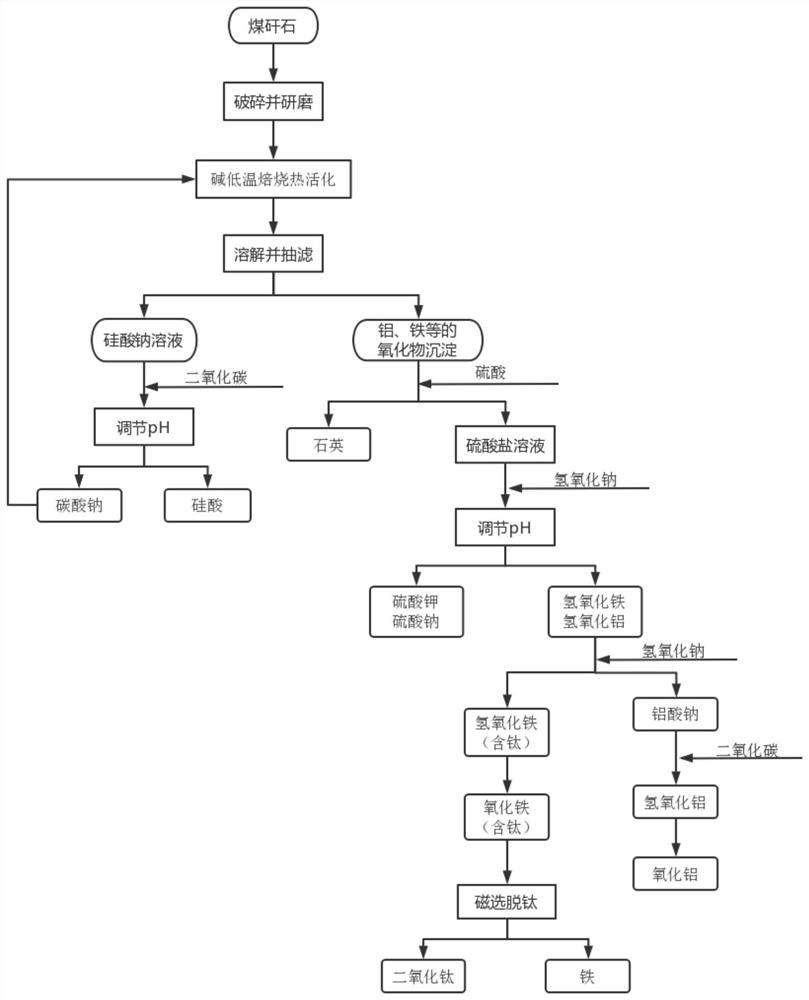Method for extracting valuable elements from coal gangue
A technology of valuable elements and coal gangue, applied in chemical instruments and methods, silica, inorganic chemistry, etc., to achieve the effect of improving activity
- Summary
- Abstract
- Description
- Claims
- Application Information
AI Technical Summary
Problems solved by technology
Method used
Image
Examples
Embodiment 1
[0049] This embodiment provides a method for extracting valuable elements from coal gangue, such as figure 1 shown, including the following steps:
[0050] S1: Crush and grind coal gangue to 74 μm, remove carbon and sulfur, mix it with sodium carbonate at a ratio of 1:1.5, and roast it in a trolley furnace at 830°C for 120 minutes to obtain activated minerals. After activation, most of the silica is converted into sodium silicate.
[0051] S2: Dissolving the activated mineral in water at 85° C., stirring continuously, and suction filtering to obtain sodium silicate solution and slag.
[0052] S3: Introduce carbon dioxide into the sodium silicate solution to precipitate silicic acid, and produce sodium carbonate for recycling;
[0053] After sulfuric acid is added to the slag for dissolution, a sediment and a supernatant are obtained; the sediment is crystalline insoluble silicon dioxide, and the supernatant is a solution rich in iron and aluminum ions.
[0054] S4: Using so...
Embodiment 2
[0060] This embodiment provides a method for extracting valuable elements from coal gangue, such as figure 1 shown, including the following steps:
[0061] S1: Crush and grind coal gangue to 36 μm, remove carbon and sulfur, mix it with sodium carbonate at a ratio of 1:1.2, and roast it in a trolley furnace at 830°C for 70 minutes to obtain activated minerals. After activation, most of the silica is converted into sodium silicate.
[0062] S2: Dissolving the activated mineral in water at 80° C., stirring continuously, and suction filtering to obtain sodium silicate solution and slag.
[0063] S3: Introduce carbon dioxide into the sodium silicate solution to precipitate silicic acid, and produce sodium carbonate for recycling;
[0064] After sulfuric acid is added to the slag for dissolution, a sediment and a supernatant are obtained; the sediment is crystalline insoluble silicon dioxide, and the supernatant is a solution rich in iron and aluminum ions.
[0065] S4: Using sod...
Embodiment 3
[0071] This embodiment provides a method for extracting valuable elements from coal gangue, such as figure 1 shown, including the following steps:
[0072] S1: Crush and grind coal gangue to 15 μm, remove carbon and sulfur, mix it with sodium carbonate at a ratio of 1:1.2, and roast it in a trolley furnace at 830°C for 70 minutes to obtain activated minerals. After activation, most of the silica is converted into sodium silicate.
[0073] S2: Dissolving the activated mineral in water at 90° C., stirring continuously, and suction filtering to obtain sodium silicate solution and slag.
[0074] S3: Introduce carbon dioxide into the sodium silicate solution to precipitate silicic acid, and produce sodium carbonate for recycling;
[0075] After sulfuric acid is added to the slag for dissolution, a sediment and a supernatant are obtained; the sediment is crystalline insoluble silicon dioxide, and the supernatant is a solution rich in iron and aluminum ions.
[0076] S4: Using sod...
PUM
| Property | Measurement | Unit |
|---|---|---|
| particle diameter | aaaaa | aaaaa |
Abstract
Description
Claims
Application Information
 Login to View More
Login to View More - R&D
- Intellectual Property
- Life Sciences
- Materials
- Tech Scout
- Unparalleled Data Quality
- Higher Quality Content
- 60% Fewer Hallucinations
Browse by: Latest US Patents, China's latest patents, Technical Efficacy Thesaurus, Application Domain, Technology Topic, Popular Technical Reports.
© 2025 PatSnap. All rights reserved.Legal|Privacy policy|Modern Slavery Act Transparency Statement|Sitemap|About US| Contact US: help@patsnap.com

